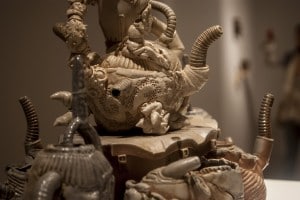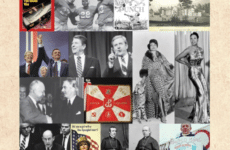By: Quisan Taylor-Lawhon- Mosaic Staff Writer
One step into the galley is one step into another world. Your eyes dart from pillar to pillar then wall-to-wall. The gallery is filled with white pillars. Each pillar is no more than three feet tall and nearly glowing, due to the high beam spotlights from above. The shadows from the pillars lie across the smooth hardwood floor, looking as if they are a part of the ambiance. Atop each pillar and even mounted on the walls are small sculptures. At a glance, the sculptures are a mixture of industrial fixtures, underwater forms and creatures. If one takes a closer look; however, the eye picks up on many little details, textures, and colors.
Students and faculty gather to immerse themselves into Nick Sevigney’s alternative world at the opening of his art exhibit in the Dorrance H. Hamilton Gallery, Thursday, September 27th. Yet the chatter within the hallway suddenly subsides as you enter the gallery. Once you’re inside, everyone is having another kind of chat – a conversation with the sculptures themselves. You see students and faculty leaning and starring – almost in an endless gaze – at the sculptures and sketches.
No one seems to notice the rapid click and flash of my camera. All the attention was on Nick’s work. Sophomore Samantha Nigro (’15), an art major and biology minor, referred to Nick’s aesthetic as “very mechanical and yet at the same time organic, which is why I like it. It’s very intricate.”
Seeming to float around the room, Nick himself speaks to different students and faculty about his sculptures. Having seen him earlier that day, it was no surprise that he was full of smiles and eager to talk to any student or onlooker in the gallery.
Entering the ceramics studio at 9 a.m. that day, Nick was off cutting, rolling, stacking and burning clay – demonstrating what he does in his own studio to produce his signature style pieces. Taking questions from ceramic students and joking with the Art Department professors, Jay Lacouture and Gerry Perrino, Nick was full of energy- making the room buzz with laughter.
“ Meeting Jay, again like he [Jay] emphasized, was so happen stance – things like that. Jay came when I was in grad school and we just hit if off. He’s frenchy, I’m frenchy, so we can make fun of each other,” says Nick.
Along with showing his secret tricks and tools, Nick was intent on sharing how valuable maintaining a close art community was. From his class demonstration Nick, Jay and Gerry shared how they knew each other from their graduate years.
Over the years these men have maintained contact and have collaborated and networked amongst each other at many stages of their lives. Now as teachers, with Jay and Gerry both teaching at Salve Regina University together and Nick teaching at Plymouth State University in New Hampshire, they can invite and collaborate at workshops from school to school.
The stories, shared by Nick, Jay and Gerry were hilariously entertaining, but most importantly enlightening to young artists. Many times students forget that their peers can be their greatest resource and biggest support system. Nick’s message of taking advantage of the people that you know within your department and in your community stayed with me. This concept is universal throughout the Salve community and it reminds us to stay connected.
The future can certainly be improved if you maintain a good support system from your past. Many of the connections and opportunities for Nick occurred because of the advice and help of his network of art friends and mentors.
Nick brought not only tricks and advice for students taking ceramics, but he sent a message Salve students can use. Staying in contact with peers and professors – building a lifelong world full of supportive people – may be the edge you have over competitors in the future.















